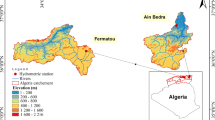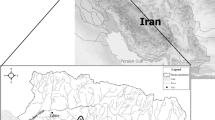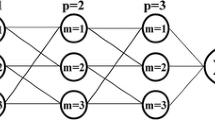Abstract
Hydrological and statistical models are playing an increasing role in hydrological forecasting, particularly for river basins with data of different temporal scales. In this study, statistical models, e.g. artificial neural networks, adaptive network-based fuzzy inference system, genetic programming, least squares support vector machine, multiple linear regression, were developed, based on parametric optimization methods such as particle swarm optimization (PSO), genetic algorithm (GA), and data-preprocessing techniques such as wavelet decomposition (WD) for river flow modelling using daily streamflow data from four hydrological stations for a period of 1954–2009. These models were used for 1-, 3- and 5-day streamflow forecasting and the better model was used for uncertainty evaluation using bootstrap resampling method. Meanwhile, a simple conceptual hydrological model GR4J was used to evaluate parametric uncertainty based on generalized likelihood uncertainty estimation method. Results indicated that: (1) GA and PSO did not help improve the forecast performance of the model. However, the hybrid model with WD significantly improved the forecast performance; (2) the hybrid model with WD as a data preprocessing procedure can clarify hydrological effects of water reservoirs and can capture peak high/low flow changes; (3) Forecast accuracy of data-driven models is significantly influenced by the availability of streamflow data. More human interferences from the upper to the lower East River basin can help to introduce greater uncertainty in streamflow forecasts; (4) The structure of GR4J may introduce larger parametric uncertainty at the Longchuan station than at the Boluo station in the East river basin. This study provides a theoretical background for data-driven model-based streamflow forecasting and a comprehensive view about data and parametric uncertainty in data-scarce river basins.













Similar content being viewed by others
References
Abbott MB, Bathurst JC, Cunge JA, O’Connell PE, Rasmussen J (1986a) An introduction to the European Hydrological System—Systeme Hydrologique Europeen, “SHE”, 1: history and philosophy of a physically-based, distributed modelling system. J Hydrol 87(1–2):45–59
Abbott MB, Bathurst JC, Cunge JA, O’Connell PE, Rasmussen J (1986b) An introduction to the European Hydrological System—Systeme Hydrologique Europeen, “SHE”, 2: structure of a physically-based, distributed modelling system. J Hydrol 87(1–2):61–77
Adamowski J, Sun K (2010) Development of a coupled wavelet transform and neural network method for flow forecasting of non-perennial rivers in semi-arid watersheds. J Hydrol 390(1–2):85–91
Alazzy Alaa Alden, Lü Haishen, Zhu Yonghua (2015) Assessing the uncertainty of the Xinanjiang rainfall–runoff model: effect of the likelihood function choice on the GLUE method. J Hydrol Eng 20(10):04015016
Bergström, S (1976) Development and application of a conceptual runoff model for scandinavian catchments, department of water resources engineering, lund institute of technology, bulletin series A 52, Swedish meteorological and hydrological institute, Norrköping, Sweden
Beven K, Binley A (1992) The future of distributed models: model calibration and uncertainty prediction. Hydrol Process 6(3):279–298
Brabets PT, Walvoord AM (2009) Trends in streamflow in the Yukon River Basin from 1944 to 2005 and the influence of Pacific Decadal Oscillation. J Hydrol 371:108–119
Chen YD, Zhang Q, Xiao M, Singh VP (2013) Evaluation of risk of hydrological droughts by the trivariate Plackett copula in the East River basin (China). Nat Hazards 68:529–547
Dorado JL, RabuñAL JR, Pazos A, Rivero D, Santos A, Puertas J (2003) Prediction and modeling of the rainfall–runoff transformation of a typical urban basin using ANN and GP. Appl Artif Intell 17(4):329–343
El-Nasr AA, Arnold JG, Feyen J, Berlamont J (2005) Modelling the hydrology of a catchment using a distributed and a semi-distributed model. Hydrol Process 19(3):573–587
Garro BA, Vázquez RA (2015) Designing artificial neural networks using particle swarm optimization algorithms. Comput Intell Neurosci. https://doi.org/10.1155/2015/369298
George SS (2007) Streamflow in the Winnipeg River basin, Canada: Trends, extremes and climate linkages. J Hydrol 332:396–411
Govindaraju RS, Artific ATCA (2000) Artificial neural network in hydrology. I: perliminary concepts. J Hydrol Eng 5(2):115–123
He ZB, Wen XH, Liu H, Du J (2014) A comparative study of artificial neural network, adaptive neuro fuzzy inference system and support vector machine for forecasting river flow in the semiarid mountain region. J Hydrol 509:379–386
Kasiviswanathan KS, Sudheer KP (2013) Quantification of the predictive uncertainty of artificial neural network based river flow forecast models. Stoch Env Res Risk Assess 27(1):137–146
Kisi O (2009) Neural networks and wavelet conjunction model for intermittent streamflow forecasting. J Hydrol Eng 14(8):773–782
Le Moine N, Andréassian V, Mathevet T (2008) Confronting surface-and groundwater balances on the La Rochefoucauld-Touvre karstic system (Charente, France). Water Resour Res 44:W03403. https://doi.org/10.1029/2007WR005984
Lin Kairong, Liu Pan, He Yanhu, Guo Shenglian (2014) Multi-site evaluation to reduce parameter uncertainty in a conceptual hydrological modeling within the GLUE framework. J Hydroinf 16(1):60–73
Liu J, Zhang Q, Singh VP, Shi P (2016) Contribution of multiple climatic variables and human activities to streamflow changes across China. J Hydrol 545:145–162
Magar RB, Jothiprakash V (2011) Intermittent reservoir daily-inflow prediction using lumped and distributed data multi-linear regression models. J Earth Syst Sci 120(6):1067–1084
Makkeasorn A, Chang NB, Zhou X (2008) Short-term streamflow forecasting with global climate change implications—a comparative study between genetic programming and neural network models. J Hydrol 352(3–4):336–354
McCuen RH (2002) Modeling Hydrologic Change: Statistical Methods. CRC Press, Boca Raton
Mehr AD, Kahya E, Bagheri F, Deliktas E (2014a) Successive-station monthly streamflow prediction using neuro-wavelet technique. Earth Sci Inf 7(4):217–229
Mehr AD, Kahya E, Yerdelen C (2014b) Linear genetic programming application for successive-station monthly streamflow prediction. Comput Geosci 70:63–72
Mehr AD, Kahya E, Şahin A, Nazemosadat MJ (2015) Successive-station monthly streamflow prediction using different artificial neural network algorithms. Int J Environ Sci Technol 12(7):2191–2200
Milly PCD, Betancourt J, Falkenmark M, Hirsch RM, Kundzewicz ZW, Lettenmaier DP, Stouffer RJ (2008) Stationarity is dead: whither water management? Science 319:573–574
Harlan D, Wangsadipura M, Munaja, CM (2010) Rainfall–runoff modeling of Citarum Hulu River basin by using GR4J. In: Proceedings of the world congress on engineering, vol. 2. pp 2078-0958
Nourani V, Kisi Ö, Komasi M (2011) Two hybrid artificial intelligence approaches for modeling rainfall–runoff process. J Hydrol 402(1):41–59
Nourani V, Baghanam AH, Adamowski J, Kisi O (2014) Applications of hybrid wavelet–artificial Intelligence models in hydrology: a review. J Hydrol 514:358–377
Pagano T, Hapuarachchi P, Wang QJ (2010) Continuous rainfall–runoff model comparison and short-term daily streamflow forecast skill evaluation. CSIRO: Water for a Healthy Country National Research Flagship, Canberra
Pai PF (2006) System reliability forecasting by support vector machines with genetic algorithms. Math Comput Model 43(3–4):262–274
Perrin C, Michel C, Andréassian V (2003) Improvement of a parsimonious model for streamflow simulation. J Hydrol 279(1):275–289
Pramanik N, Panda RK, Singh A (2011) Daily river flow forecasting using wavelet ANN hybrid models. J Hydroinf 13(1):49–63
Samsudin R, Saad P, Shabri A (2011) River flow time series using least squares support vector machines. Hydrol Earth Syst Sci 15(6):1835–1852
Sharma S, Srivastava P, Fang X, Kalin L (2015) Performance comparison of adoptive neuro fuzzy inference system (ANFIS) with loading simulation program C++ (LSPC) model for streamflow simulation in El Nino southern oscillation (ENSO)-affected watershed. Expert Syst Appl 42(4):2213–2223
Shen ZY, Chen L, Chen T (2012) Analysis of parameter uncertainty in hydrological and sediment modeling using GLUE method: a case study of SWAT model applied to Three Gorges Reservoir Region, China. Hydrol Earth Syst Sci 16(1):121
Shiri J, Kisi O (2010) Short-term and long-term streamflow forecasting using a wavelet and neuro-fuzzy conjunction model. J Hydrol 394(3–4):486–493
Srivastav RK, Sudheer KP, Chaubey I (2007) A simplified approach to quantifying predictive and parametric uncertainty in artificial neural network hydrologic models. Water Resour Res 43:W10407
Sudheer KP, Gosain AK, Ramasastri KS (2002) A data-driven algorithm for constructing artificial neural network rainfall–runoff models. Hydrol Process 16:1325–1330
Sudheer C, Maheswaran R, Panigrahi B, Mathur S (2014) A hybrid SVM-PSO model for forecasting monthly streamflow. Neural Comput Appl 24(6):1381–1389
Tiwari MK, Chatterjee C (2010) Uncertainty assessment and ensemble flood forecasting using bootstrap based artificial neural networks (BANNs). J Hydrol 382(1):20–33
Tongal H, Booij MJ (2017) Quantification of parametric uncertainty of ANN models with GLUE method for different streamflow dynamics. Stoch Env Res Risk Assess 31(4):993–1010
Toth E, Brath A (2007) Multistep ahead streamflow forecasting: role of calibration data in conceptual and neural network modeling. Water Resour Res 43(11):1–11
Wang XK, Lu WZ, Cao SY, Fang D (2007) Using time-delay neural network combined with genetic algorithms to predict runoff level of Linshan Watershed, Sichuan, China. J Hydrol Eng 12(2):231–236
Wang K, Zhang Q, Chen YD, Singh VP (2015) Effects of LUCC on hydrological processes using a GIS/RS-based integrated hydrologic model: the East River as a case study. Hydrol Sci J 60(10):1724–1738
Wood AW, Leung LR, Sridhar V, Lettenmaier DP (2004) Hydrological implications of dynamical and statistical approaches to downscaling climate model outputs. Clim Change 62:189–216
Wu MC, Lin GF, Lin HY (2014) Improving the forecasts of extreme streamflow by support vector regression with the data extracted by self-organizing map. Hydrol Process 28(2):386–397
Zhang Q, Xu C-Y, Chen YD, Jiang J (2009) Abrupt behaviors of the streamflow of the Pearl River basin and implications for hydrological alterations across the Pearl River Delta, China. J Hydrol 377:274–283
Zhang Q, Jiang T, Chen YD, Chen XH (2010) Changing properties of hydrological extremes in south China: natural variations or human influences? Hydrol Process 24:1421–1432
Zhang Q, Xiao M, Liu C-L, Singh VP (2014) Reservoir-induced hydrological alterations and ecological instream flow in the East River, the Pearl River basin, China. Stoch Env Res Risk Assess 28(8):2119–2131
Zhang Q, Gu X, Singh VP, Xu C-Y, Kong D, Xiao M, Chen X (2015a) Homogenization of precipitation and flow regimes across China: changing properties, causes and implications. J Hydrol 530:462–475
Zhang Q, Gu X, Singh VP, Chen X (2015b) Evaluation of ecological instream flow using multiple ecological indicators with consideration of hydrological alterations. J Hydrol 529(3):711–722
Acknowledgements
This work is financially supported by the National Science Foundation for Distinguished Young Scholars of China (Grant No.: 51425903), the Fund for Creative Research Groups of National Natural Science Foundation of China (Grant No.: 41621061), the Key Project of National Natural Science Foundation of China (Grant No.: 51190091) and by National Natural Science Foundation of China (No.: 41401052). Our cordial gratitude should be extended to the editor-in-chief, George Christakos, Ph.D., ScD, PE, RSM, and two anonymous reviewers for their professional and pertinent comments and suggestions which are greatly helpful for further improvement of the quality of this manuscript.
Author information
Authors and Affiliations
Corresponding author
Rights and permissions
About this article
Cite this article
Zhang, Z., Zhang, Q., Singh, V.P. et al. River flow modelling: comparison of performance and evaluation of uncertainty using data-driven models and conceptual hydrological model. Stoch Environ Res Risk Assess 32, 2667–2682 (2018). https://doi.org/10.1007/s00477-018-1536-y
Published:
Issue Date:
DOI: https://doi.org/10.1007/s00477-018-1536-y




